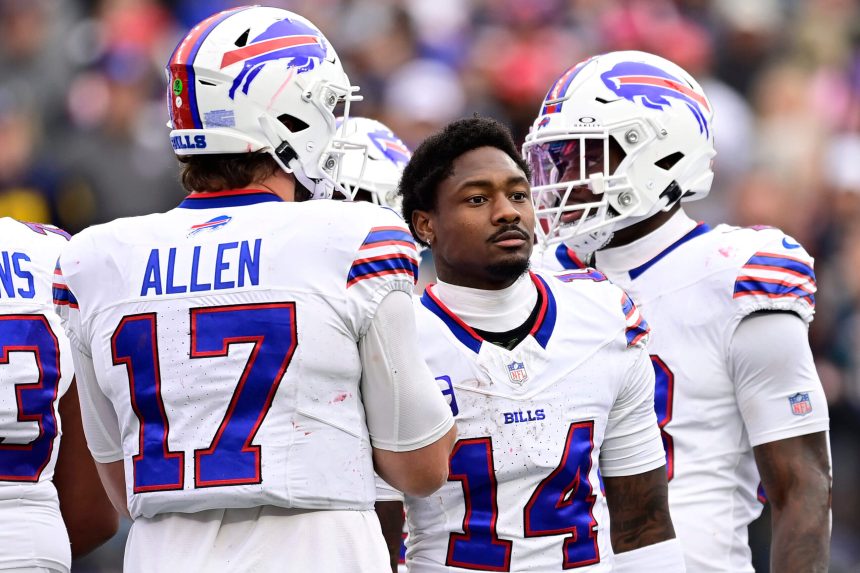After Stefon Diggs spent four years helping the Buffalo Bills to new heights on the offensive side of the ball and helping Josh Allen reach his full potential as a franchise quarterback, the two sides have split. The Bills agreed to trade Diggs to the Houston Texans on Wednesday, netting a 2025 second-round pick, while also sending a 2025 fifth-round pick and 2024 sixth-round pick to Houston.
It’s a jarring deal for multiple reasons. From a roster standpoint, it leaves the Bills pretty thin at wide receiver, as Diggs has been their rock of a No. 1 wideout over the last four seasons. From a cap perspective, trading Diggs tacks on nearly $4 million more to his cap hit of nearly $28 million. The timing is rough, too, as the move comes well after the initial wave of free agency and after last year’s No. 2 wideout, Gabe Davis, moved on to Jacksonville. On top of it all, many are wondering if the Bills and general manager Brandon Beane got enough in return for someone who had such an extreme on-field impact at times.
So it all raises the question: Why trade Diggs now? And where do the Bills go from here?
We’ve agreed to terms on a trade that will send WR Stefon Diggs to Houston for a 2025 second round draft pick.
More details: https://t.co/qidbgR9zfQ pic.twitter.com/J3IHJeDxN9
— Buffalo Bills (@BuffaloBills) April 3, 2024
The Bills had been going through the offseason with the belief that Diggs would be on the roster and would be in their plans for 2024, according to a source with knowledge of the situation. Beane spent the offseason publicly giving Diggs votes of confidence. In February, Beane said he expected Diggs to be with the team in 2024. In January, the GM said the team believed Diggs was a true No. 1 receiver in the NFL.
Those weren’t just moments of lip service. They likely weren’t expecting to deal Diggs given his age, his nearly $28 million cap hit and the amount of cap space they needed to clear before the new league year began in mid-March. That’s before his importance to the offense was even factored in.
But the deal came together rather quickly. According to a source briefed on the matter, the Texans presented the Bills with an offer for Diggs on Tuesday, which set forward a 24-hour period of internal discussions by the Bills about dealing their star receiver. Those discussions even looped in ownership. The Bills agreed to the deal shortly before 11 a.m. ET on Wednesday, when Beane called Diggs to inform him of the trade.
Now, the Bills are left looking to replenish their wide receiver corps. So what changed about the Bills’ situation that helped them feel comfortable enough to move on from Diggs?
The first school of thought is that this might be one of the last chances the Bills had to maximize Diggs’ value in a trade before having to eat a lot of dead cap without getting much in return. Diggs put together an outstanding first half of the 2023 season, one that had him on pace to set career records. But the second half of the year yielded inconsistent results and, at times, a maddening lack of involvement. On top of it all, Diggs turned 30 in late November which, to NFL types, is usually the age at which natural abilities begin to unravel. Plus, with some Diggs fatigue that was happening over time, it checked several boxes for the Bills.

GO DEEPER
Graham: Bills’ patience wore thin with Stefon Diggs. Now he’s gone
From a draft perspective, considering this year’s values, only netting a future second-round pick is the price-tag equivalent of getting a third-round pick this year. However, the Bills likely are looking at that former Minnesota Vikings’ second-round pick with the hope it will become a pretty good one. The Vikings are likely to have a transitional year, either with Sam Darnold or a rookie quarterback playing against what’s looking like a very tough NFC North. If things break correctly and the Vikings take a plunge in the standings, that pick could wind up as an early second-round selection.
The Bills also took advantage of all their cap clearing preceding this deal, which also helps explain why they felt comfortable trading Diggs now. Before the trade, the Bills had around $6 or $7 million in cap space. But that was before the $10 million-plus boost in cap space they received for the Tre’Davious White post-June 1 designation. While they still need space for their rookie draft class, it’s nowhere close to the $16-plus million in cap space they would have had on June 1.
They had the flexibility to take on the additional $4 million cap hit now. While it takes away room for some post-draft dealings and creates a need to replace another starter, it also completely takes Diggs off the Bills’ 2025 books, while getting what could be an early second-round pick to do it. If the Bills hung on to Diggs for 2024 and either traded him for a likely much lesser pick next year or flat-out released him, they would have had a dead-cap charge of more than $22 million on their books. They used taking on more of a dead-cap charge right now as leverage for a better pick.
The one commonality throughout this offseason — with all their restructuring, trades, cap casualties and contracts — is that they are looking to foster a healthy cap environment in 2025 when they can potentially become bigger players in the free-agent market. The Diggs cap charge will be totally gone. The likely outcome is for them to move on from Von Miller next offseason, too. Those two moves alone will save them nearly $36 million on the 2025 salary cap. They’re already projected to be under the 2025 salary cap before any additional moves, and that’s with Allen’s massive $43.2 million cap hit next year.
There is no doubt that the most significant deterrent to this deal is that it makes their offense markedly worse for 2024. Their actions have screamed that this season was a bit of a mini reset, to get a bit younger and cheaper and avoid the massive cap deficit they faced this offseason in the future, all while keeping most of their core starters together. But without question, the draft pick and ample breathing room in 2025 come at the cost of moving on from their best receiver.
It leaves the team with Curtis Samuel, Khalil Shakir and Mack Hollins as their presumed top three receivers. Samuel and Shakir are options to become the new starting Z receiver, with the other likely starting in the slot. Those two also will do a bit of switching back and forth. Hollins and the contract he signed is an insurance policy at X receiver should things not go their way in the draft. The Bills are clearly far from complete when it comes to their receiver depth chart.
Even before the Diggs trade, wide receiver was a huge need. It has gone from a screaming need to a 10,000-pound polka-dotted elephant waving hello in the middle of their depth chart. The Bills are going to draft a receiver at some point, likely early. The strength of this receiver class likely plays a role in the timing of the trade, too, because now Beane can really dig in on a move up the board, especially after losing out on the third-round compensatory pick they spent all season thinking they’d get.

GO DEEPER
Grading the Stefon Diggs trade: Texans vault into Super Bowl mix; Bills shed salary, drama
Beane and the Bills have been plenty aggressive with draft-day trades before. But now, armed with another second-round pick in next year’s draft, nothing should be ruled out regarding a massive move up the board. If the Bills can get their hands on Marvin Harrison Jr., Malik Nabers or Rome Odunze — or even Brian Thomas Jr. later in the first round — it would give them both a starter and a potential long-term No. 1 to pair with Allen. That would be the ultimate move that signals they are still quite serious about winning in 2024.
Regardless, Diggs will forever be known as one of the most prolific receivers in franchise history, one who helped unearth what could be the best quarterback the Bills have ever had. He has long had the reputation of being an incredibly smart, thoughtful and motivated player who works extremely hard at his craft, despite some of the drama that follows him. By moving Diggs, the Bills attempted to keep it all moving forward in a year where they could afford it. While their ceiling for 2024 is in question, the Bills are looking at this as a short-term loss for the long-term betterment of their entire cap situation and an offer they just couldn’t say no to, considering all the circumstances.
(Photo: Billie Weiss / Getty Images)











